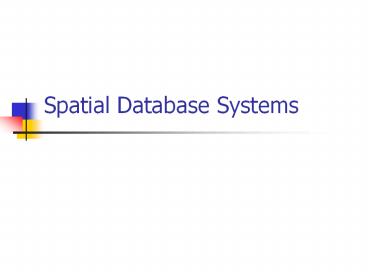Spatial Database Systems - PowerPoint PPT Presentation
1 / 13
Title:
Spatial Database Systems
Description:
Spatial Database Systems Spatial Database Applications GIS applications (maps): Urban planning, route optimization, fire or pollution monitoring, utility networks ... – PowerPoint PPT presentation
Number of Views:141
Avg rating:3.0/5.0
Title: Spatial Database Systems
1
Spatial Database Systems
2
Spatial Database Applications
- GIS applications (maps)
- Urban planning, route optimization, fire or
pollution monitoring, utility networks, etc - Other applications
- VLSI design, CAD/CAM, model of human brain, etc
- Traditional applications
- Multidimensional records
3
What is a Spatial Database?
- A SDBMS is a DBMS
- It offers spatial data types/data models/ query
language - Support spatial properties/operations
- It supports spatial data types in its
implementation - Support spatial indexing, algorithms for spatial
selection and join
4
Spatial Representation
- Raster model
- Vector model
5
Spatial data types
region
point
line
- Point 2 real numbers
- Line sequence of points
- Region area included inside n-points
6
Spatial Relationships
- Topological relationships
- adjacent, inside, disjoint, etc
- Direction relationships
- Above, below, north_of, etc
- Metric relationships
- distance lt 100
- And operations to express the relationships
7
Models, Algebras, Languages
- Extent relational model, or use Object-relational
model define new ADTs - Spatial algebra ex. ROSE algebra
- Query languages
- Extend SQL GEOQL, PSQL
- New graphical languages GEO-SAL
8
Examples
- A database
- Relation states(sname string, area region,
spop int) - Relation cities(cname string, center point
ext region) - Relation rivers(rname string, routeline)
- SELECT FROM rivers WHERE route intersects R
- SELECT cname, sname FROM cities, states WHERE
center inside area - SELECT rname, length(intersection(route,
California)) FROM rivers WHERE route intersects
California
9
Spatial Queries
- Selection queries Find all objects inside query
q, inside-gt intersects, north - Nearest Neighbor-queries Find the closets
object to a query point q, k-closest objects - Spatial join queries Two spatial relations S1
and S2, find all pairs x in S1, y in S2, and x
rel y true, rel intersect, inside, etc
10
Access Methods
- Point Access Methods (PAMs)
- Index methods for 2 or 3-dimensional points (k-d
trees, Z-ordering, grid-file) - Spatial Access Methods (SAMs)
- Index methods for 2 or 3-dimensional regions and
points (R-trees)
11
Indexing using SAMs
- Approximate each region with a simple shape
usually Minimum Bounding Rectangle (MBR) (x1,
x2), (y1, y2)
y2
y1
x2
x1
12
Indexing using SAMs (cont.)
- Two steps
- Filtering step Find all the MBRs (using the SAM)
that satisfy the query - Refinement stepFor each qualified MBR, check the
original object against the query
13
Spatial Indexing
- Point Access Methods (PAMs) vs Spatial Access
Methods (SAMs) - PAM index only point data
- Hierarchical (tree-based) structures
- Multidimensional Hashing
- Space filling curve
- SAM index both points and regions
- Transformations
- Overlapping regions
- Clipping methods

